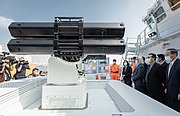|
NCSIST 2.75in rockets remote weapon station
NCSIST 2.75in rockets remote weapon station is a Taiwanese remote weapon station made by NCSIST to launch Mk66 2.75inch rockets. The system is eligible of using multiple types of fuzing techniques to cope with the needs of the user in both military and policing scenarios.[3] HistoryDuring the development stage, the team of engineers at NCSIST highly utilized experiences that they had gained during the previous developments of the Kestrel ATM and XTR-101/102 systems. The team first displayed a system called "Coastal Defense Rocket Artillery System" with 12 7-cell pods at TADTE (Taipei Aerospace and Defense Exhibition) 2015, but didn't receive any orders, or much interest, from the ROC Army.[4] The system than was set aside until the CGA established "Plan of Procuring CG Vessels (2018 to 2027)", which gave the team an opportunity to persuade the system for CG usage. Due to the high need of 40mm guns (namely the Bofors 40mm), there's no excess guns for the CGA to use in arsenal. Therefore, the CGA turned to a modified version of the artillery system prototype with 6 turrets instead of the original 12 for use on Anping-class OPVs and Chiayi-class OPVs.[5] Design and DevelopmentThe shipborne version debuted at the commission ceremony of the ROC Coast Guard 600 ton OPV, where it was given the name "鎮海火箭彈系統" (in traditional Chinese form). Due to the low need of massive fire projection, the Coast Guard version is solely armed with 6 launch pods, each featuring 7 rockets. The warheads are then derived into "High Explosive", "Anti-Armor", and "Area Destruction", along a later version of "Lighting" for SAR missions. The "Lighting" version can last for more than five minutes to support continuous operations at night.[3] During the first batch of the RWS, the system experienced issues on low operable elevation due to the overall height of the system. Later on, starting from the forth delivery of the Anping-class OPVs, the team developed a new version featuring an integrated cupola and elevated pedestal, which expanded the possible operating scenarios and elevation.[6] Gallery
References
|
||||||||||||||||||||||||||||||||||||||||||||





